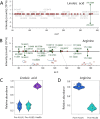Dysregulated arginine metabolism in precursor B-cell acute lymphoblastic leukemia in children: a metabolomic study
- PMID: 39174946
- PMCID: PMC11340190
- DOI: 10.1186/s12887-024-05015-3
Dysregulated arginine metabolism in precursor B-cell acute lymphoblastic leukemia in children: a metabolomic study
Abstract
Background: Precursor B-cell acute lymphoblastic leukemia (B-ALL) is the most common cancers in children. Failure of induction chemotherapy is a major factor leading to relapse and death in children with B-ALL. Given the importance of altered metabolites in the carcinogenesis of pediatric B-ALL, studying the metabolic profile of children with B-ALL during induction chemotherapy and in different minimal residual disease (MRD) status may contribute to the management of pediatric B-ALL.
Methods: We collected paired peripheral blood plasma samples from children with B-ALL at pre- and post-induction chemotherapy and analyzed the metabolomic profiling of these samples by ultra-high performance liquid chromatography-mass spectrometry (UHPLC-MS). Healthy children were included as controls. We selected metabolites that were depleted in pediatric B-ALL and analyzed the concentrations in pediatric B-ALL samples. In vitro, we study the effects of the selected metabolites on the viability of ALL cell lines and the sensitivity to conventional chemotherapeutic agents in ALL cell lines.
Results: Forty-four metabolites were identified with different levels between groups. KEGG pathway enrichment analyses revealed that dysregulated linoleic acid (LA) metabolism and arginine (Arg) biosynthesis were closely associated with pediatric B-ALL. We confirmed that LA and Arg were decreased in pediatric B-ALL samples. The treatment of LA and Arg inhibited the viability of NALM-6 and RS4;11 cells in a dose-dependent manner, respectively. Moreover, Arg increased the sensitivity of B-ALL cells to L-asparaginase and daunorubicin.
Conclusion: Arginine increases the sensitivity of B-ALL cells to the conventional chemotherapeutic drugs L-asparaginase and daunorubicin. This may represent a promising therapeutic approach.
Keywords: Arginine; Linoleic acid; Metabolomic profiling; Minimal residual disease; Precursor B-cell acute lymphoblastic leukemia.
© 2024. The Author(s).
Conflict of interest statement
The authors declare no competing interests.
Figures






Similar articles
-
Metabolomic profiling identifies pathways associated with minimal residual disease in childhood acute lymphoblastic leukaemia.EBioMedicine. 2019 Oct;48:49-57. doi: 10.1016/j.ebiom.2019.09.033. Epub 2019 Oct 17. EBioMedicine. 2019. PMID: 31631039 Free PMC article.
-
LC-MS analysis of serum lipidomic and metabolomic signatures in pediatric patients with acute lymphoblastic leukemia.Ital J Pediatr. 2025 Mar 12;51(1):74. doi: 10.1186/s13052-025-01921-z. Ital J Pediatr. 2025. PMID: 40075508 Free PMC article.
-
Flow-cytometric minimal residual disease monitoring in blood predicts relapse risk in pediatric B-cell precursor acute lymphoblastic leukemia in trial AIEOP-BFM-ALL 2000.Pediatr Blood Cancer. 2019 May;66(5):e27590. doi: 10.1002/pbc.27590. Epub 2018 Dec 18. Pediatr Blood Cancer. 2019. PMID: 30561169 Clinical Trial.
-
Low relapse rate in children with acute lymphoblastic leukemia after risk-directed therapy.J Pediatr Hematol Oncol. 2001 Dec;23(9):591-7. doi: 10.1097/00043426-200112000-00008. J Pediatr Hematol Oncol. 2001. PMID: 11902303 Review.
-
[Therapeutic strategies for childhood high-risk acute lymphoblastic leukemia].Beijing Da Xue Xue Bao Yi Xue Ban. 2013 Apr 18;45(2):327-32. Beijing Da Xue Xue Bao Yi Xue Ban. 2013. PMID: 23591360 Review. Chinese.
Cited by
-
Potential Antitumor Mechanism of Propolis Against Skin Squamous Cell Carcinoma A431 Cells Based on Untargeted Metabolomics.Int J Mol Sci. 2024 Oct 19;25(20):11265. doi: 10.3390/ijms252011265. Int J Mol Sci. 2024. PMID: 39457046 Free PMC article.
-
Evaluation of Metabolic Characteristics Induced by Deoxynivalenol in 3D4/21 Cells.Animals (Basel). 2025 Aug 7;15(15):2324. doi: 10.3390/ani15152324. Animals (Basel). 2025. PMID: 40805114 Free PMC article.
References
MeSH terms
Substances
Grants and funding
LinkOut - more resources
Full Text Sources

